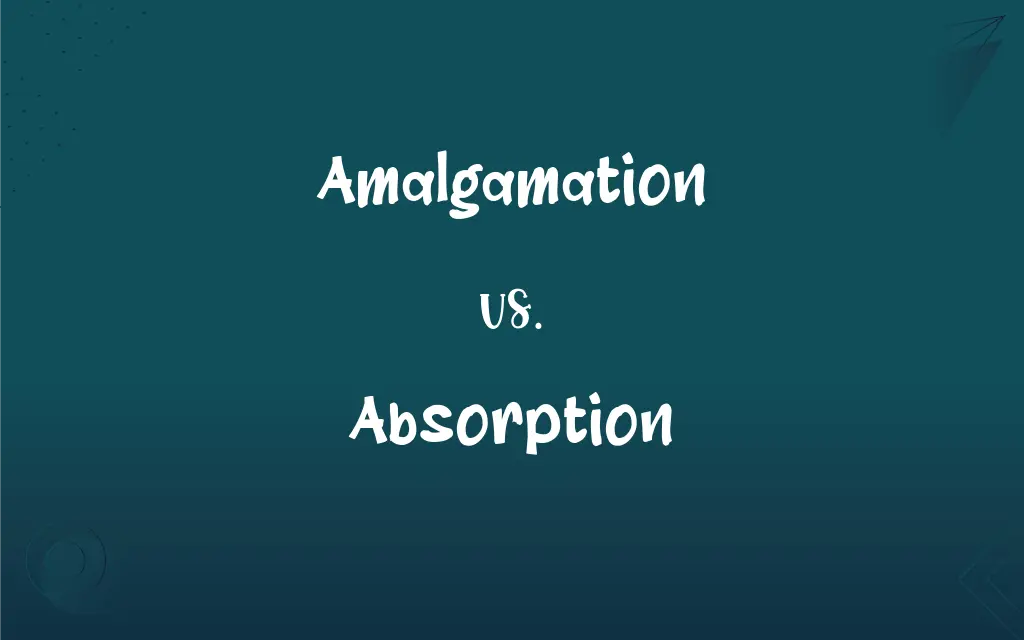Amalgamation vs. Absorption: What's the Difference?
Edited by Aimie Carlson || By Harlon Moss || Updated on October 9, 2023
Amalgamation is the process of combining two or more companies into a new entity, while absorption involves one company completely acquiring and dissolving another.

Key Differences
Amalgamation refers to a process in which two or more entities come together to form a new, united whole. This is often seen in the business realm where companies merge to create a single new entity, generally to pool resources, expand reach, or increase capacities. Absorption, on the other hand, denotes a scenario where one entity takes over another, incorporating its assets and operations, and the absorbed entity ceases to exist. This dissolving entity is enveloped into the dominant one, typically because it may provide a strategic advantage in terms of resources or market share.
In amalgamation, entities typically unite on relatively equal terms, coming together to harness collective resources, skills, and market presence. Both, or all, participating entities dissolve to form a completely new entity, usually with a new identity, which may be crafted to encapsulate the strengths and visions of its predecessors. Whereas, in absorption, the absorbing entity retains its identity and continues its operations, simply expanding to accommodate the assets and functionalities of the absorbed entity, which ceases to exist post the process.
Amalgamation tends to be a collective decision of merging entities, wherein mutual benefits are identified, and strategies are aligned to ensure that the resulting formation is stronger and more viable in the market. On the contrary, absorption might not be characterized by such mutuality. It might happen that the absorbing company simply identifies a strategic fit or advantage in acquiring another company and assimilates it, even if the latter might prefer to retain its independence.
In the lens of business ethics and strategy, amalgamation is usually a path taken to strategically ensure stability, reduce competition, or gain synergistic advantages by pooling competencies and resources of the merging entities. Absorption can sometimes be perceived as a more aggressive strategy where one business seeks to enhance its position by completely taking over and dissolving another, possibly to eliminate competition, gain critical resources, or consolidate its market position.
Comparison Chart
Resulting Entity
Forms a new entity
Absorbing entity continues
ADVERTISEMENT
Entities Involved
All are dissolved to form a new entity
One is dissolved, the other remains
Basis
Mutual agreement typically
Can be unilateral from the absorbing firm
Strategy
Collaborative
Can be seen as aggressive
Identity
New identity is formed
Retains the identity of absorbing entity
Amalgamation and Absorption Definitions
Amalgamation
Amalgamation creates a new entity from two or more entities.
The amalgamation of the tech companies resulted in a powerful new player in the industry.
ADVERTISEMENT
Absorption
Absorption entails one entity taking over another.
The software startup faced absorption by the tech giant.
Amalgamation
Amalgamation is usually a mutually agreed-upon process.
The artists chose amalgamation to create a novel style that reflected their combined influences.
Absorption
Absorption incorporates the assets of the absorbed into the absorber.
Through the absorption, the company acquired new technologies and customer bases.
Amalgamation
Amalgamation combines resources and competencies.
The amalgamation of their talents created a formidable team in the competition.
Absorption
Absorption might involve a change in management and operations for the absorbed entity.
After the absorption, the employees faced adjustments to new management styles and policies.
Amalgamation
Amalgamation may aim for synergistic advantages.
Through amalgamation, the firms sought to explore synergies in their research and development efforts.
Absorption
Absorption causes the absorbed entity to cease existence.
The absorption of the small retailer by the chain saw the original brand disappear.
Amalgamation
Amalgamation involves mutual dissolution of original entities.
The banks underwent amalgamation to enhance their capital base and customer reach.
Absorption
Absorption can be a strategy to eliminate competition.
The absorption of the rival firm immediately expanded their market share.
Amalgamation
The act of amalgamating or the condition resulting from this act.
Absorption
The act or process of absorbing or the condition of being absorbed.
Amalgamation
A consolidation or merger, as of several corporations.
FAQs
Does an absorbed company continue to exist?
No, in absorption, the absorbed company ceases to exist and is integrated into the absorbing company.
What is the key distinction between amalgamation and absorption?
Amalgamation forms a new entity from two or more entities, while absorption involves one entity taking over another.
What happens to the identity of companies in amalgamation?
In amalgamation, the merging companies dissolve and create a new identity for the newly formed entity.
Why might companies choose amalgamation?
Companies might opt for amalgamation to pool resources, expand reach, reduce competition, or achieve synergies.
Is absorption always hostile?
Not necessarily, absorption can be either hostile or friendly, depending on the agreement between the entities involved.
How does absorption impact the market share of the absorbing company?
Absorption typically enhances the market share of the absorbing company as it assimilates the customer base and operations of the absorbed one.
What is the legal process behind amalgamation?
Amalgamation usually involves legal procedures including approval from regulatory bodies, compliance with laws, and possible shareholder voting.
Can a smaller company absorb a larger one?
Yes, a smaller company can absorb a larger one, often facilitated by leveraging various financing methods, though it's less common.
How does amalgamation affect the stakeholders involved?
Amalgamation may impact stakeholders, including investors, employees, and customers, by altering company structure, operations, and offerings.
What factors influence the success of absorption?
Factors like strategic alignment, cultural fit, and effective integration of operations often influence the success of absorption.
Do customers benefit from amalgamation?
Customers might experience varied effects; they could benefit from enhanced offerings or face reduced options due to decreased competition.
How are the assets and liabilities treated in amalgamation?
In amalgamation, assets and liabilities of merging companies are usually pooled together and allocated to the newly formed entity.
Can an absorption occur without the consent of the absorbed company?
While possible, especially in hostile takeovers, legal frameworks often require some level of agreement or a favorable vote by shareholders.
What are the financial implications of absorption for the absorbing company?
The absorbing company may gain assets but also assumes liabilities, which can have varied financial implications depending on the absorbed entity’s status.
What are the tax implications of amalgamation?
Tax implications of amalgamation can vary by jurisdiction but might involve benefits like carry-forward of losses to the newly formed entity.
How are the employees affected in amalgamation?
Employees may face changes in management, policies, and culture post-amalgamation, and some may experience redundancy if roles overlap.
Can absorption be reversed?
Absorption is typically irreversible as the absorbed company ceases to exist, although its components might be sold or spun off in the future.
How is the new entity formed through amalgamation named?
The new entity may adopt a new name or combine the names of the amalgamating companies, subject to legal and branding considerations.
How does the stock market typically react to absorption?
Stock market reactions to absorption can vary, sometimes applauding synergies via rising stock prices, or expressing concern through declines.
What are the common reasons for a company to undergo absorption?
Companies may pursue absorption to eliminate competition, acquire resources or technology, and expand market share or geographical presence.
About Author
Written by
Harlon MossHarlon is a seasoned quality moderator and accomplished content writer for Difference Wiki. An alumnus of the prestigious University of California, he earned his degree in Computer Science. Leveraging his academic background, Harlon brings a meticulous and informed perspective to his work, ensuring content accuracy and excellence.
Edited by
Aimie CarlsonAimie Carlson, holding a master's degree in English literature, is a fervent English language enthusiast. She lends her writing talents to Difference Wiki, a prominent website that specializes in comparisons, offering readers insightful analyses that both captivate and inform.







































































